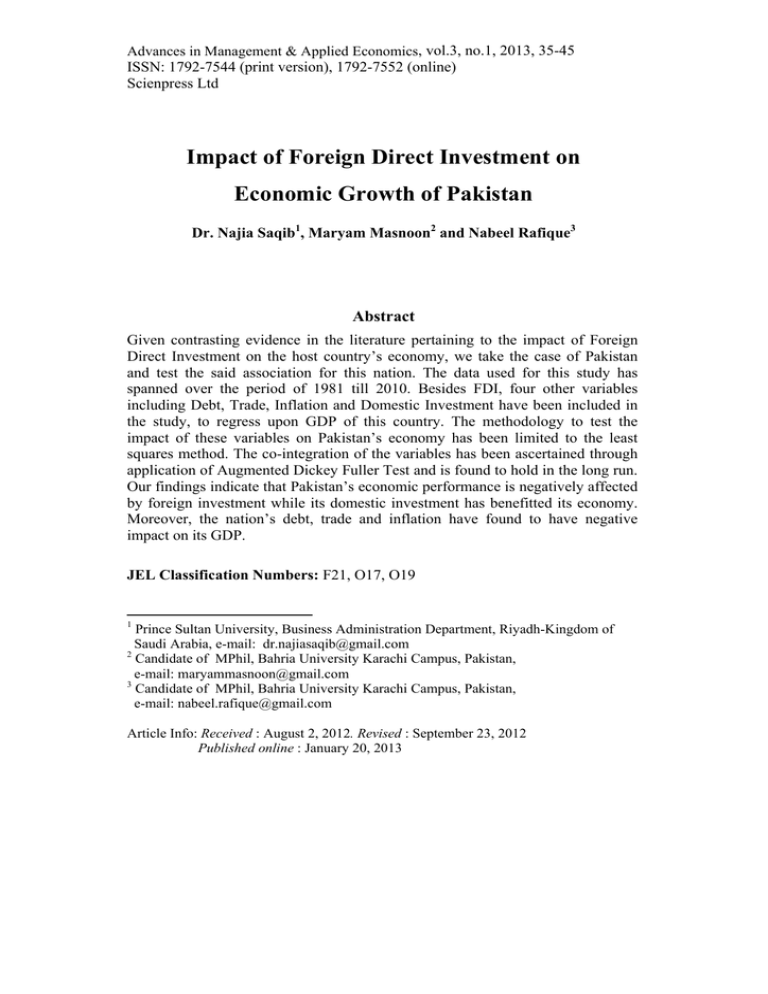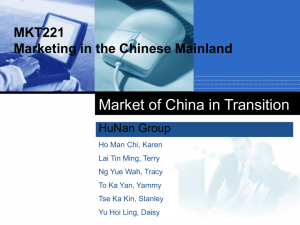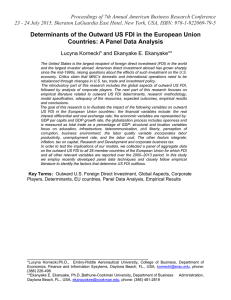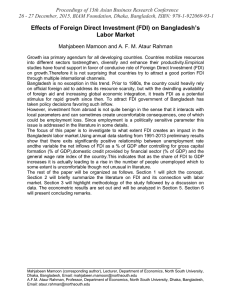Impact of Foreign Direct Investment on Economic Growth of Pakistan Abstract
advertisement

Advances in Management & Applied Economics, vol.3, no.1, 2013, 35-45 ISSN: 1792-7544 (print version), 1792-7552 (online) Scienpress Ltd Impact of Foreign Direct Investment on Economic Growth of Pakistan Dr. Najia Saqib1, Maryam Masnoon2 and Nabeel Rafique3 Abstract Given contrasting evidence in the literature pertaining to the impact of Foreign Direct Investment on the host country’s economy, we take the case of Pakistan and test the said association for this nation. The data used for this study has spanned over the period of 1981 till 2010. Besides FDI, four other variables including Debt, Trade, Inflation and Domestic Investment have been included in the study, to regress upon GDP of this country. The methodology to test the impact of these variables on Pakistan’s economy has been limited to the least squares method. The co-integration of the variables has been ascertained through application of Augmented Dickey Fuller Test and is found to hold in the long run. Our findings indicate that Pakistan’s economic performance is negatively affected by foreign investment while its domestic investment has benefitted its economy. Moreover, the nation’s debt, trade and inflation have found to have negative impact on its GDP. JEL Classification Numbers: F21, O17, O19 1 Prince Sultan University, Business Administration Department, Riyadh-Kingdom of Saudi Arabia, e-mail: dr.najiasaqib@gmail.com 2 Candidate of MPhil, Bahria University Karachi Campus, Pakistan, e-mail: maryammasnoon@gmail.com 3 Candidate of MPhil, Bahria University Karachi Campus, Pakistan, e-mail: nabeel.rafique@gmail.com Article Info: Received : August 2, 2012. Revised : September 23, 2012 Published online : January 20, 2013 36 Impact of Foreign Direct Investment on Economic Growth of Pakistan Keywords: Foreign direct investment, economic growth, Granger causality 1 Introduction Economic Performance and economic growth of a country is influenced by multiple factors. For economies in general and developing economies in particular, Foreign Direct Investment (FDI) has been observed and argued as a significant determinant. However there remain two contrasting views. Esther & Folorunso (2011) [1] have investigated the impact of FDI flows on economic growth in Nigeria. Their study found that FDI had a beneficial impact on the economic growth. However, they also report that the extent to which FDI influences the economic growth positively could be limited by human capital. Zakia & Ziad (2007) [2] have also tested the effect FDI on the economic growth of Jordan, in conjunction with testing the imports on the same dependant variable, over the period (1976-2003). The estimated results point toward the existence of bidirectional relationships between FDI and output, and between imports and output as well. The results have indicated supporting evidence of FDI and import-Led Growth Hypothesis for Jordan. Thomas, et al. (2008) [3] have argued that multinational corporations’ investment in the host country imposes the pressure on the local firms to develop new technologies and innovate. This also explains the reason the developing countries are interested in taking measures that attract foreign direct investment. Largely, the developing countries face the issue of gap between savings and investment which has to be bridged by FDI. This results in technology transfer, job creation, and productivity increase and competition enhancement. [Kobrin (2005) [4] and Le and Ataullah (2006) [5]]. Such benefits have encouraged the developing nations, including Pakistan, to attract FDI inflows. In order to ascertain the existence of such benefits, many studies have been conducted to check the impacts of FDI on growth. However, theories and empirical literature happen to offer mixed indication regarding the impact of FDI on economic growth in developing countries. This paper is an attempt to examine the impact of FDI on economic growth in concurrence of four other variables including debt, domestic investment, inflation and trade. The rest of the paper is organized as follows: Section 2 discusses the theoretical and empirical literature on the relationship between FDI and economic growth. Data estimation, model specification and definition of variables is given in Section 3. Section 4 provides the empirical findings while Section 5 concludes our findings and discusses our results. Dr. Najia Saqib, Maryam Masnoon and Nabeel Rafique 37 2 Empirical Literature Pakistan is historically a reputed investment area where British companies dominated two hundred years. In 1970s, specifically in Zulfiqar Ali Bhutto Regime, Pakistan started to have nationalization process. However, after few decades, it has been realized to show the attitude towards privatization to catch-up globalization process. Pakistan economy is not matured enough to play a part in globalization process to get benefits to a large extent, and consequently this economy is facing difficulties. Adams (2009) [6] argued that ‘the theoretical link between Foreign Direct Investment and economic growth can be found in modernization and dependency theories’. Modernization theory suggests that since economic growth requires capital investment, FDI could serve as the engine to the economic growth. However, the new growth theory highlights that it is the knowledge transfer through FDI to the developing countries that are scarce in the necessary infrastructure and education. Besides, FDI also brings to the host country a set of managerial skills and marketing knowledge. Mamun and Nath (2005) [7] has argued in support of the modernization theory claiming that FDI plays a dual function by contributing to capital accumulation and by increasing total factor productivity. Quite the opposite, the dependency theory suggests that if a nation depends on foreign investment, then its economic growth would face a negative impact. This is because Foreign Direct Investment creates monopolies in the industrial sector, which consequently results in under-utilization of domestic resources (Adams, 2009) [6]. Consequently lead to an implication that the economy is mainly dominated by foreign investors and does not experience organic growth (Amin, 1974) [8]. Therefore, the multiplier effect is weak and leads to stagnant growth in developing countries (Adams, 2009) [6]. The aforementioned mixed theoretical framework leads the empirical studies conducted by various scholars e.g. Shah et al (2003) [9], Borensztein, et al. (1998) [10], Makki and Somwaru (2004) [11], Campos and Kinoshita (2002) [12] and Zhang (2001) [13] among others. For example, Zhang (2001) [13] reported that FDI promotes economic growth in countries where the domestic infrastructure is well developed and trade and FDI policies are more liberal. Balasubramanyam, et al. (1996) [14] concluded that FDI has more growth increasing effects in those countries where the labor force is highly educated and which is following export promotion trade policies rather than import substitution trade policies. Campos and Kinoshita (2002) [12] state that FDI would only have positive effect on economy of the host country if FDI is in the shape of pure technology transfer. Similarly, some studies find insignificant effects of FDI on growth [e.g. Akinlo (2004) [15], Aynwale (2007) [16]and Hermes and Lensink (2003) [17] reported by Arshad & Shujaat 2011[18]]. Arshad & Shujaat (2011) [18] further reported that Hermes and Lensink (2003) [17] concluded that FDI exerts significant negative effect on the host country. Similar results were found by Agosin and Mayer (2000) 38 Impact of Foreign Direct Investment on Economic Growth of Pakistan [19] and Sylwester (2005) [20]. De Mello (1997) [21] argues that the direction of causality depends on the recipient country’s trade regime. Nair- Reichert and Weinhold (2001) [22] argue that the effect of FDI on growth is highly heterogeneous across countries and this heterogeneity is more pronounced for more open economies. Therefore, in order to attract or channelize FDI in host country there is a need for host country-specific study, its policy analysis. The policy regime, infrastructure situation / capital formation, technology status, labor education status will be the determinants for the causality and effect of FDI and economic growth. 3 Data and Estimation The data for Pakistan is taken from two sources, both deemed reliable, State Bank of Pakistan and World Development Indicators. The time series data pertains to years 1981 till 2010. GDPt = ß0 + ß1FDIt + ß2Dt + ß3GDSt + ß4INFt + ß5Tt + εt Table 1: Determinants of economic performance, panel data of Pakistan Variables Expected Sign Dependant Variable: Economic Performance Proxy Data Source GDP Per Capita at PPP ($) World Development Indicators State Bank of Pakistan Explanatory variables: Foreign Direct Investment Debt - FDI per Capita ($) - Log of Total Debt Services Gross Domestic Investment + Inflation - Gross Domestic Savings as Percentage of GDP Inflation, GDP Deflator Trade - Source: Authors’ Expectations Trade as percentage of GDP World Development Indicators World Development Indicators World Development Indicators World Development Indicators Dr. Najia Saqib, Maryam Masnoon and Nabeel Rafique 39 The model consists of six variables, GDP per Capita (GDP), foreign direct investment per Capita (FDI), Log of Total Debt Service (D), Gross Domestic Saving (GDS) as percentage of GDP, Inflation GDP (INF) and Trade as a percentage of GDP (T). The subscript‘t’ represents respective variables at time t. Amongst these variables, GDP is specified as the dependent variable and the remaining five as the explanatory variables. Table 1 shows the explanatory variables and their expected signs along with the proxy used and the source of the data. 3.1 Real GDP Per Capita at Purchasing Power Parities. Our dependent variable in this case is Economic Performance for which we use Real GDP per Capita at PPP. We have found in literature (Roubini and Sala-iMartin, 1992 [23], and King and Levine, 1993) [24]that GDP per Capita has been used as a proxy for economic growth. Another reason for using GDP per capita is to incorporate the population effect. 3.2 Foreign Direct Investment Per Capita Foreign Direct Investment is essential and significant forecaster of the Economic Growth (Kowalski, 2000 [25]). FDI in long run has negative relationship with Economic Growth (Kogid et al, 2010 [26]; Tsai, 1994 [27]). FDI is a stimulator for economic growth in under-developed countries (Tsai, 1994 [27]). This author further argues that Foreign Direct Investment provides external capital and advance technology to the economy which acts as an engine to the economic growth. However we are trying to test if the dependency theory holds in case of Pakistan, as mix results have been documented in the literature. Akram, et al. (2011) [28] have established negative association of FDI with GDP growth by taking panel data of SAARC countries. The proxy used for FDI is the FDI per Capita in US$. Data for this variable is taken from the State Bank of Pakistan. The expected sign for foreign direct investment is negative. 3.3 Total Debt A heavily indebted economy is perceived to be in trouble (Kowalski, 2000 [25]). It is argued that the external debt is a problem for the economy (Fosu, 1996 [29]). Debt is one of the key determinants of macroeconomic growth (Kowalski, 2000 [25]). Association between economic growth and Total Debt is found to be negative (Amjad & Khan, 2004 [30]; Kowalski, 2000 [25]). The proxy used for 40 Impact of Foreign Direct Investment on Economic Growth of Pakistan Total Debt is Total Debt and Services (US $). The data for the Debt is taken from the World Development Indicators. 3.4 Gross Domestics Investment Gross Domestics Investment pertains to the contribution of Government of the country towards its economy (Kowalski, 2000 [25]). The literature purports a positive relationship between gross domestic investment and the economic growth (Kogid et al, 2010 [26]; Amjad & Khan, 2004 [30]; Baroo, 1996 [31]). The proxy used for this variable is Gross Domestic Savings as percentage of GDP. The data for this is taken from World Development Indicators. 3.5 Inflation Kowalski (Kowalski, 2000 [25]) argues that inflation determines steadiness of the economy of the country. If the Inflation level is high, then that could be translated into an escalating level of problem for the economy. A negative relationship between inflation and economic growth has been documented in the literature. The proxy for this variable is Inflation, GDP deflator (annual %). Data for this variable is derived from World Development Indicators. We expect a negative correlation of this variable with our dependant variable, in line with the literature. 3.6 Trade Trade has been taken as one of the key variable affecting economic growth. Trade openness has been widely used with a proxy of trade to GDP ratio in the literature, eg. (Beck et al. 2000 [32]) and (Waheed & Younus, 2010 [33]). We have used Trade as a percentage of GDP as a proxy for trade variable and expect this variable to have a negative sign because of high imports as compared to exports. The data has been taken from World Development Indicators. 4 Empirical Results Before running the Ordinary Least Square (OLS) Method to approximate the coefficients of the regression equation, we tested for the stationarity of the variables. The stationarity of the time series is tested using the Augmented Dickey Fuller (ADF) test. Dr. Najia Saqib, Maryam Masnoon and Nabeel Rafique 41 Table 2: Stationarity test results Variables I(0) C&T C ADF test statistics I(1) C C&T C I(2) C&T GDP 0.81 -1.58 - 2.22 -2.56 -5.56* -5.45* FDI D GDS INF T -3.17** -1.86 -1.79 -4.36* -2.51 -4.16** -3.35** -1.27 -4.73* -2.54 -4.48* -7.37* -6.45* -7.04* -6.37* -5.45* -7.22* -6.95* -6.92* -6.33* - - Note: *1%, **5% and ***10% level of significance. Source: Authors’ estimation. Each series is tested at levels, and with the only exception of ‘FDI’, all variables are found to have unit-root and the series are non-stationary at levels. FDI is stationary at l(0) at 5% significance level. ADF is again employed at first difference and the results exhibit that ‘INF’, ‘GDS’ and ‘T’ are stationary at 1st difference, at 1% level of significance. Our dependent variable ‘GDP’ is found to be stationary at 2nd difference at 1% level of significance. Table 3: Summary of results for time series of 1981-2010 Variables Coefficients t-Statistic P-value Constant FDI Debt Inflation Trade Domestic Investment -0.137 -21.99 -2.20 - 7.78 -25.53 38.75 - 0.9656 -3.124 -1.952 -3.1076 -2.3279 5.728 0.3452 0.0000 0.081 0.000 0.015 0.000 Adjusted R2 Durbin Watson Statistic F-Statistic Probability(F-Statistic) Source: Authors’ Estimation 0.962 1.931 42.24 0.000 42 Impact of Foreign Direct Investment on Economic Growth of Pakistan Our findings indicate a negative and significant relationship between our focus variable FDI and dependent variable GDP. Similarly Debt, Inflation and Trade have also exhibited negative relationship with GDP. With the exception of Debt, all variables have shown significant influence on our dependent variable. However, co-integration must exist for this relationship to be long-term. According to Engle Granger (1987) [34] procedure, co-integration exists if the residuals are found to be stationary. Hence, we employed Augmented Dickey Fuller Test for this purpose and found to be stationary. Table 4 is an exhibit of this test. Table 4: Residuals stationarity test ADF Test Statistic Probability With Intercept With Intercept & Trend -5.536 0.0001 -7.285 0.000 Note: McKinnon critical values for intercept at 1% level = -3.737853, and for Intercept & Trend at 1% level = -0.440739 Source: Authors’ Estimation Table 4 shows that the ADF statistic is greater than the critical value at all levels, hence we can state that the error term is stationary at a high significance level. And therefore we conclude that the negative relationship of FDI and GDP hold in the long run. 5 Conclusion and Implications The conflicting evidence found in the empirical literature led us to expect that the foreign direct investment in a developing nation like Pakistan would be negatively affecting its economic performance and growth, and that the dependency theory was expected to hold in this case. Our research findings have remained consistent with our initial expectations and have indicated that FDI has a negative role to play in this economy. Not just FDI, but Debt, Trade and Inflation have also been found to negatively influence Pakistan’s economic performance. A developing nation like Pakistan that is abundant in many resources may help from capital formation. Domestic investment in this regard would benefit the country’s economy, and therefore dependency on foreign investment should remain limited. Moreover, in our study, the association of the variables is also proved to hold in the long run. Hence, economic policies limiting FDI in Pakistan and encouraging domestic saving and investment should be formulated and implemented. It seems Dr. Najia Saqib, Maryam Masnoon and Nabeel Rafique 43 that most of the benefits of Foreign Investment get diluted at the hands of the repatriation of profits back to the investor nation. This can be explained by the limited capacity of the host country to absorb the transfer of knowledge and technology for further development. 6 Further Research Suggestions The relationship between Foreign Investment and host country’s economy is intermediated as well as moderated by several other variables that have not been taken into account in this study for the purpose of parsimony. Empirical Literature indicates that technology spillover effect of FDI is a strong intermediating variable. We suggest that an appropriate proxy for this variable be identified and measured to further develop on this research. In addition, another key variable of amount of Human Capital available in the host country may have a moderating influence on the original relationship of FDI and GDP. We therefore suggest further study incorporating these variables in order to better propose policy recommendations. References [1] Esther O. Adegbite, Folorunso. S. Ayadi, The role of foreign direct investment in economic development: A study of Nigeria, World Journal of Entrepreneurship, Management and Sustainable Development, 6(1/2), (2011), 133-147. [2] Zakia Mishal, Ziad Abulaila, The Impact of Foreign Direct Investment and Imports on Economic Growth: The Case of Jordan, Journal of Economic and Administrative Sciences, 23(1), (2007), 1-31. [3] H. Thomas, X. Li and X. Liu, Ownership Structure and Now Product Development in Transnational Corporation in China, Transnational Corporations, 17(2), (2008), 17-44. [4] S. Kobrin, The Determinants of Liberalisation of FDI Policy in Developing Countries: 1991-2001, Transnational Corporations, (2005), 14(1), 67-103. [5] M.H. Le and A. Ataullah, Foreign Capital and Economic Performance of Pakistan, The Lahore Journal of Economics, 7(1), (2006), 1-32. [6] S. Adams, Foreign Direct Investment, Domestic Investment, and Economic Growth in Sub-Saharan Africa, Journal of Policy Modelling, Working Paper, (2009). [7] K.L. Mamun and H.K. Nath, Export-led growth in Bangladesh: a time series analysis, Applied Economics Letters, 12(6), (2005), 361-364. [8] S. Amin, Accomu lation on a World Scale: A Critique of the Theory of Underdevelopment, Monthly Press Review, New York, (1974). 44 Impact of Foreign Direct Investment on Economic Growth of Pakistan [9] Shah and Ahmed, The Determinants of Foreign Direct Investment in Pakistan: an Empirical Investigation, The Pakistan Development Review, 42(4), (2003). [10] E. Borensztein, J. De Gregorio and J-W. Lee, How Does Foreign Direct Investment Affect Economic Growth, Journal of International Economics, 45, (1998), 115-135. [11] S.S. Makki and A. Somwaru, Impact of Foreign Investment and Trade o n Economic Growth: Evidence from Developing Countries, American Journal of Agricultural Economics, 86, (2004), 795-801. [12] N. Campos and Y. Kinoshita, Foreign Direct Investment as Technology Transferred: Some Panel Evidence from the Transition Economies, The Manchester School, 70, (2002), 398-419. [13] K.H. Zhang, How Does Foreign Investment Affect Economic Growth in China? Economics of Transition, 9, (2001), 679-693. [14] V.N. Balasubramanyam, S. Mohammed and D. Sapaford, FDI and Growth in EP and IS Countries, Economic Journal, 106(10), (1996), 92-105. [15] A. Akinolo, Foreign Direct Investment and Growth in Nigeria: An Empirical Investigation, Journal of Policy Modelling, 26, (2004), 627-639. [16] A.B. Ayanwale, FDI and Economic Growth: Evidence from Nigeria, Nairobi, African Economic Research Consortium Paper, 165, (2007). [17] N. Hermes and R. Lensink, Foreign Direct Investment, Financial Development and Economic Growth, The Journal of Development Studies, 40, (2003), 142-163. [18] Arshad and Shujaat, Foreign Direct Investment and Economic Growth in Pakistan: Sectoral Analysis, PIDE Working Paper, 67, (2011). [19] M. Agosin and R. Mayer, Foreign Direct Investment: Does It Crowd in Domestic Investment? United Nations Conference on Trade and Development Geneva, Switzerland, Working Paper, 146, (2000). [20] K. Sylwester, Foreign Direct Investment, Growth, and Income Inequality in Less Developing Countries, International Review of Applied Economics, 19(3), (2005), 289-300. [21] Jr. L.R. De Mello, Foreign Direct Investment in Developing Countries and Growth: A Selective Survey. The Journal of Development Studies, 34, (1997), 1-34. [22] U. Nair-Reichert and D. Weinhold, Causality Tests for Cross-Country Panels: A New Look at FDI and Economic Growth in Developing Countries, Oxford Bulletin of Economics and Statistics, 63, (2001), 153-171. [23] N. Roubini and X. Sala-i-Martin, Financial Repression and Economic Growth, Journal of Development Economics, 39, (1992), 5-30. [24] R.G. King and R. Levine, Finance and Growth: Schumpter Might Be Right, Quarterly Journal of Economics, 108(3), (1993), 717-737. [25] E. Kowalski, Determinant of Economic Growth in East Asia, Research Honors Project, (2000). Dr. Najia Saqib, Maryam Masnoon and Nabeel Rafique 45 [26] M. Kogid, D. Mulok, Y.F.L. Beatrice and K. Mansur, Determinant Factors of Economic Growth in Malaysia: Multivariate Cointegration and Causality Analysis, Euro Journals Inc, 24, (2010), 123-135. [27] L.P. Tsai, Determinant of Foreign Direct Investment and its Impact on Economic Growth, Journal of Economic Development, 19(1), (1994), 137163. [28] M. Akram, S. Manzoor, S.S. Hassan, M. Farhan and H.M. Alam, Empirical Analysis of Determinants of Economic Growth: Evidence from SAARC Countries, Journal of Economics and Behavioral Studies, 3(2), (2011), 115121. [29] K.A. Fosu, The Impact of External Debt on Economic Growth in SubSaharan Africa, Journal of Economic Development, 21(1), (1996), 93-118. [30] F. Amjad and Z.N. Khan, External Determinants of Growth and Growth Projections: SAARC and Pakistan, The Pakistan Development Review, 43(4), (2004), 737-755. [31] R.J. Baroo, Determinant of Economic Growth: A cross country empirical study, NBER Working Paper Series, (1996). [32] T. Beck, R. Levine and N. Loayza, Finance and the Sources of Growth, Journal of Financial Economics, 58, (2000), 261-300. [33] A. Waheed and N. Younus, Effect of Financial Sector’s Development and Financial Sector’s Efficiency on Economic Growth: Empirical Evidence from Developing and Developed Countries, (2010). [34] R.F. Engle and C.W.F. Granger, Co-integration and Error Correction: Representation, Estimation and Testing, Econometrica, 55(2), (1987), 251276.






